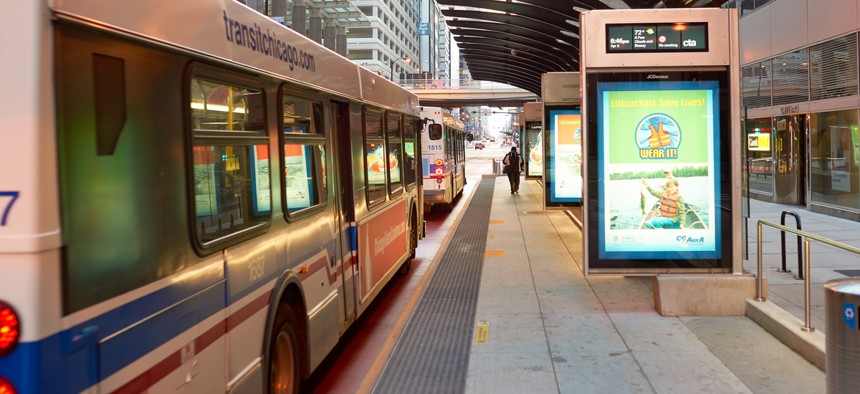The Transportation Quandary for Older and Disabled People Is Two-Fold

Buses at a stop in Chicago. Shutterstock
A recent survey shows the “great need” to serve those who can’t drive or will no longer be able to.
Older people want to stay in their homes as they age. But a recent survey finds that when it becomes time to stop driving, they just don’t know what their options are to keep getting around—if any exist.
A survey by the National Aging and Disability Transportation Center found that 68 percent of adults 60 and older who they polled this fall said it would be hard to find alternative transportation options if they needed to stop driving. The poll also included younger disabled people, who said they would struggle even more, with 80 percent responding that it would be difficult to find other alternatives.
Virginia Dize, co-director of the center, said the survey reveals the “great need” to provide for both older people and those with disabilities.
“We know there are a lot of people out there who are family caregivers in particular who are spending hours of their time either providing rides or arranging rides,” Dize said. “And we know that older adults and people with disabilities are missing out on medical care, but also missing out on continuing to stay connected with the community.”
In most communities, the problem is two-fold: people don’t know about the public transit or other options that exist and there simply isn't enough transportation alternatives, Dize said.
Only 15 percent of the 509 older adults who were polled between Oct. 19 and Nov. 5—which included both phone and online respondents—reported using public transportation and even fewer used special services like paratransit or a volunteer ride agency. Transit use was higher among younger people with disabilities, with about a third of the 513 respondents saying they used public transportation.
Dize noted that survey respondents indicated an interest in taking transit, but many don’t know about options or might be intimidated by something they haven’t tried before.
“They don’t know how to begin. They may simply have no idea if it is going to serve their needs,” Dize said. “For example, if they are in a wheelchair or use a walker or cane or move really slowly. Is this something they will be able to actually navigate?”
In places where transit exists, one successful option for educating people about how to get around is “travel training,” which can teach people how to use a local bus or subway system to get where they need to go, Dize said.
Another recent survey by RetirementLiving.com underscores how important a factor giving up driving can play in other decisions people make. That online survey of more than 2,300 older people this fall found that more than 80 percent wanted to stay in their own homes as they age, but would be moved toward assisted living if their health failed (75 percent) or when driving is no longer an option (almost 30 percent).
The NADTC survey found that options for people in rural communities were less plentiful, with 49 percent of older people who have given up driving in small towns saying they had “good” or “excellent” alternatives, compared to 62 percent of non-drivers in more populated places.
Respondents who had stopped driving reported that this new reality kept them from activities they needed or wanted to engage in. They also described feeling dependent on others, isolated and frustrated by their loss of independence.
Dize said transit agency officials and other others that might not be reaching all the people interested in their services can adopt NADTC’s “Every Ride Counts” campaign, which offers ways for cities to advertise existing programs and customize the materials.
The NADTC, which is funded in part by the Federal Transit Administration, is a collaboration between Easterseals and the National Association of Area Agencies on Aging.
Laura Maggi is the Managing Editor for Route Fifty and is based in Washington, D.C.
NEXT STORY: 3 tips for optimizing data center cooling






